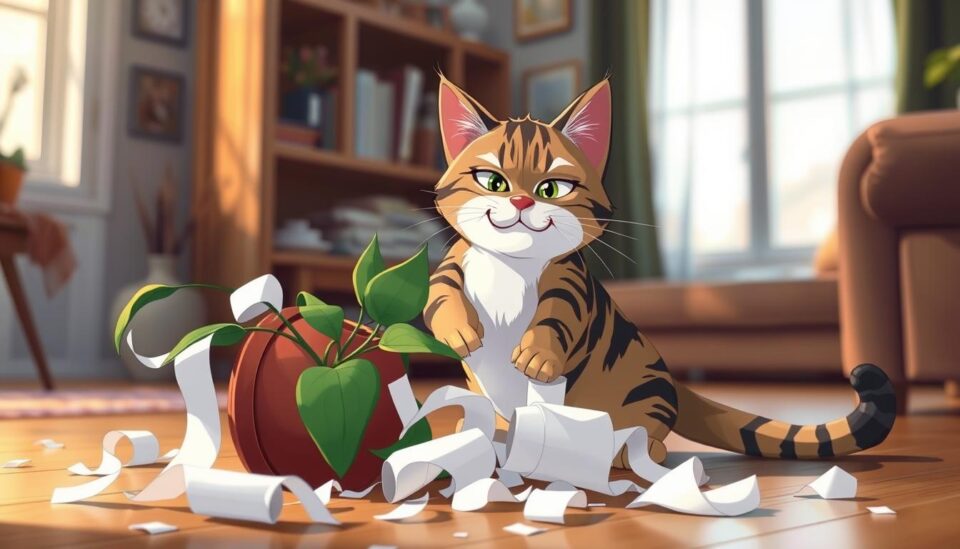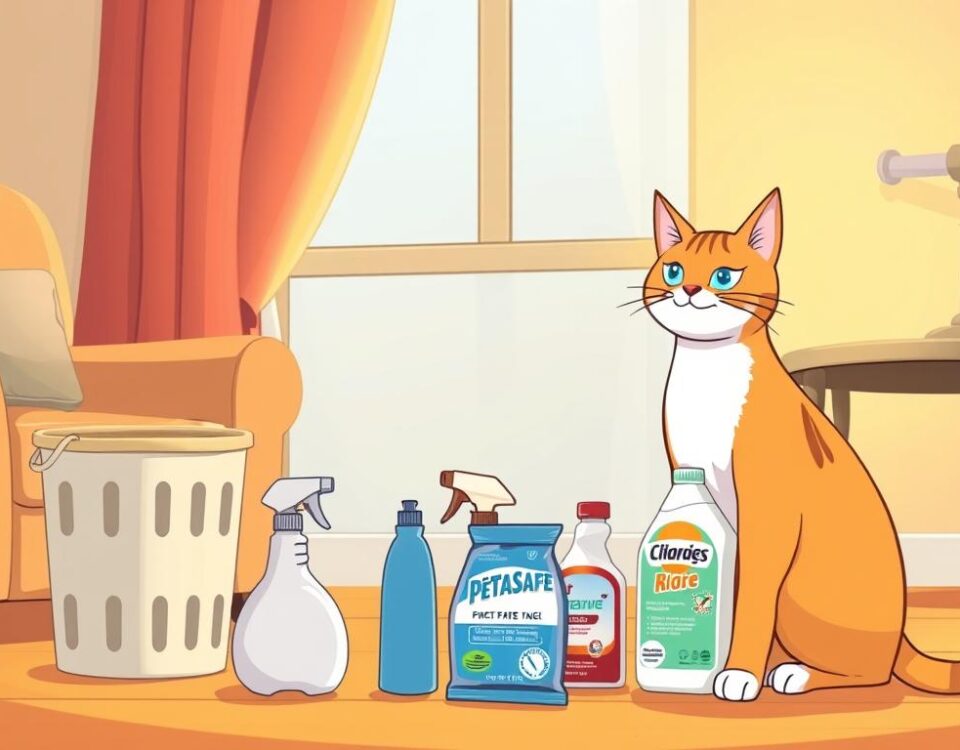
7 Home Remedies to Get Rid of Dog Bad Breath Naturally (Vet-Approved Tips)
May 18, 2025Having a cat that poops or pees outside the litter box is frustrating. It’s a common problem many cat owners face. Knowing why your cat does this is key to fixing it.
Why Is My Cat Pooping or Peeing Outside the Litter Box
There are many reasons for litter box issues. These include medical problems and stress from the environment. Figuring out the main cause is the first step to solving the problem.
This guide will cover the 9 main reasons for litter box problems. It will also give you tips on how to fix them. By understanding why your cat is acting this way, you can make your home and litter box habits better again.
Key Takeaways
- Medical issues can cause cats to avoid the litter box.
- Environmental changes can stress your cat and lead to litter box problems.
- Litter box cleanliness and size are crucial for your cat’s comfort.
- Understanding your cat’s behavior is key to resolving litter box issues.
- Patience and observation are necessary to identify and fix the problem.
Understanding Your Cat’s Litter Box Behavior
It’s important to know how your cat uses the litter box. Cats like routine, and their litter box habits show if they’re healthy. This helps keep your pet happy and healthy.
Normal Litter Box Habits in Cats
Cats usually use the litter box often and bury their waste. They like to stay clean and not mess their homes. A healthy cat will use the litter box without problems.
How often a cat goes to the litter box changes with age, diet, and health. A normal cat goes once or twice a day for pee and once a day for poop. Watching these habits helps spot any odd changes.
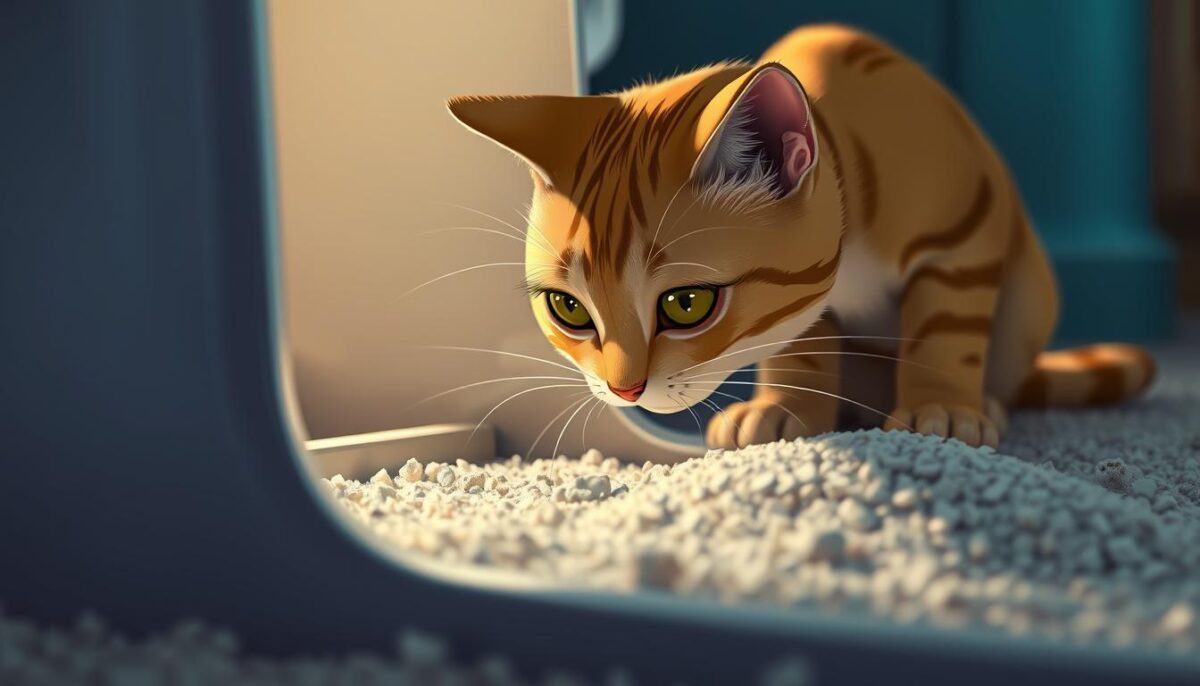
Signs of Litter Box Problems
Signs of trouble with the litter box include avoiding it, accidents outside, or changes in how often they go. These signs might mean there’s a health issue, stress, or they don’t like the litter box.
Medical problems like urinary infections or digestive issues can cause litter box problems. So can a dirty or bad litter box. Spotting these signs early helps fix the problem.
Why Is My Cat Pooping or Peeing Outside the Litter Box? 9 Common Reasons and How to Address Them
Cats are very clean animals. When they start going outside the litter box, there’s usually a reason. This can be due to health problems or stress in their environment.
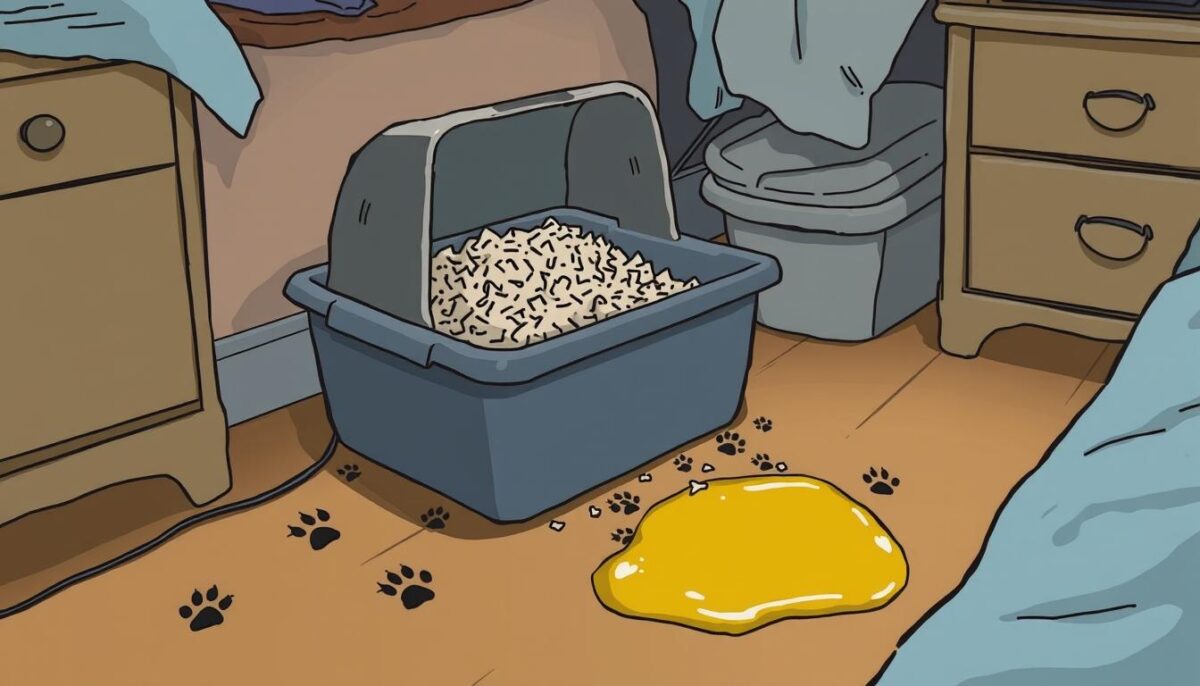
The Importance of Identifying the Root Cause
Finding out why your cat is having litter box issues is key. Medical problems, like urinary tract infections, can make cats avoid the litter box. A dirty litter box or changes at home can also cause stress.
Knowing why your cat is acting this way helps you fix the problem. You might need to change the litter, add more boxes, or reduce stress.
When to Consult a Veterinarian
If your cat starts going outside the litter box, see a vet. A vet can check for health issues like kidney stones or diabetes. They can help you figure out what to do next.
Even if your cat seems healthy, a vet can still help. They can talk about environmental or behavioral factors that might be causing the problem.
Reason1: Medical Issues
Cats may poop or pee outside the litter box for medical reasons. They often hide signs of illness. This makes it hard for owners to spot problems early.
Medical issues can include urinary tract infections and digestive disorders. These problems can make cats avoid the litter box.
Urinary Tract Infections and Bladder Problems
Urinary tract infections (UTIs) and bladder problems are common in cats. They can make cats avoid the litter box. Symptoms include frequent urination, accidents outside the litter box, and blood in the urine.
If you think your cat has a UTI, see a vet right away. They can diagnose and treat it properly.
Digestive Disorders and Constipation
Digestive disorders and constipation can also cause cats to poop outside. Constipation can be painful. Digestive disorders may cause diarrhea or stomach pain. Watching your cat’s stool and behavior can help spot these issues.
A vet can help manage these conditions. They can give advice on what to do.
How to Address Medical Causes
To fix medical causes, you need vet care and changes at home. Make sure your cat drinks plenty of water and eats well. This helps their urinary and digestive health.
Your vet might give medicine for UTIs or digestive problems. Also, reduce stress and keep the litter box clean. This can help with some medical issues.
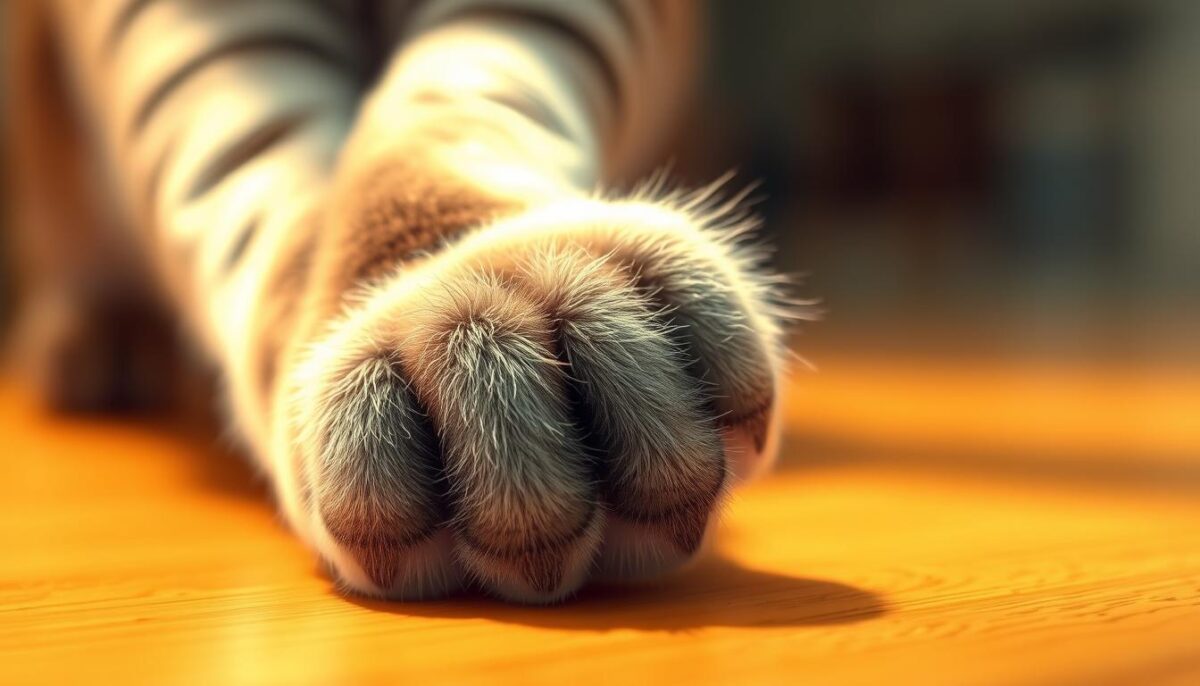
Reason2: Dirty Litter Box
Keeping the litter box clean is very important. Cats don’t like dirty smells or places. A dirty litter box can stop them from using it.
How Often Should You Clean the Litter Box?
You should clean the litter box every day. Take out the solid waste and clumps. How often to change the litter depends on the litter and how many cats you have.
For example, clumping litter should be changed every 7-10 days. Non-clumping litter might need to be changed more often.
Deep Cleaning and Maintenance Tips
Deep cleaning means washing the litter box with mild soap and warm water. It’s also good to disinfect it sometimes to kill bacteria and smells.
Tips for Deep Cleaning:
- Rinse the litter box well to get rid of soap.
- Make sure it’s dry before putting in new litter.
- Use a litter box cleaner or baking soda and water to fight smells.
Establishing a Cleaning Routine
Having a regular cleaning schedule is important. Set reminders to scoop the litter box every day. Also, remember to change the litter as needed.
| Task | Frequency |
|---|---|
| Scoop litter box | Daily |
| Change litter | Every 7-10 days (depending on litter type) |
| Deep clean litter box | Every 1-3 months |

By following these tips, you can keep your cat’s litter box clean. This will help your cat use it right.
Reason3: Inappropriate Litter Type
Cats are very picky about their litter. The wrong type can make them avoid the litter box. The litter you pick is key to your cat’s comfort and using the box.
Different Types of Cat Litter
There are many cat litters out there. You can find clumping clay, silica gel, recycled paper, pine, and walnut litters. Each has its good and bad sides. For example, clumping clay is good at controlling smells but can be dusty.
Silica gel is great at soaking up moisture but might not be good for the planet.
Finding the Right Litter for Your Cat
Think about what your cat likes when picking litter. Some cats like fine-grained litters, while others prefer bigger ones. You might need to try a few to see what your cat prefers.
| Litter Type | Advantages | Disadvantages |
|---|---|---|
| Clumping Clay | Effective odor control, forms clumps for easy cleaning | Can be dusty, may cause respiratory issues |
| Silica Gel | Excellent moisture absorption, reduces odor | Not environmentally friendly, can be expensive |
| Recycled Paper | Eco-friendly, highly absorbent | May not control odor as well, can be prone to mold |
How to Transition to a New Litter
When switching to a new litter, start by mixing a little of the new with the old. Slowly add more new litter until your cat gets used to it. This helps avoid them avoiding the litter box because of the change.
Knowing about different litters and what your cat likes helps you choose well. It also makes switching litters easier if you need to.
Reason4: Poor Litter Box Location
Where you put a litter box is very important. If it’s not in a good spot, your cat might not use it. This can lead to bad behavior.
Ideal Placement of Litter Boxes
Choose a quiet, easy-to-get-to spot for your litter box. It should be private and not near food or water. Putting it in a quiet place helps your cat use it more.
Common Location Mistakes to Avoid
Don’t put the litter box in a noisy place like near a washing machine. Or in a busy hallway. Stay away from food areas to keep your cat from avoiding it.
Relocating a Litter Box Successfully
If you need to move the litter box, do it slowly. Start by leaving it in the new spot for a few hours. Then, increase the time a bit each day. This helps your cat get used to the new spot without stress.
Reason5: Litter Box Design and Accessibility Issues
Litter box design and how easy it is to get to are key. A good litter box design makes your cat use it more. But a bad design can make your cat avoid it.
Choosing the Right Size and Style
It’s important to pick a litter box that fits your cat well. A litter box that’s too small can make your cat uncomfortable. This might cause accidents outside the box.
Look for a bigger litter box or one with low sides. This makes it easier for your cat to get in.
| Litter Box Feature | Consideration | Benefit |
|---|---|---|
| Size | Large enough for your cat to turn around | Reduces accidents outside the litter box |
| Entry Height | Low sides for easy access | Accommodates cats with mobility issues |
| Lid or Open Top | Consider your cat’s preference | Encourages litter box use |
Accommodating Cats with Special Needs
Cats with special needs need special litter boxes. Think about a litter box with a ramp or low entry point. This helps your cat get in easier.
When to Replace Your Litter Box
It’s important to know when to get a new litter box. If your litter box is old, broken, or doesn’t fit your cat’s needs anymore, it’s time for a new one. Watch for signs like your cat avoiding the litter box or having accidents. These signs mean the litter box is not good anymore.
Reasons6 and7: Stress and Territorial Issues
Stress and territorial issues can make cats change their litter box habits. Cats are very sensitive to their surroundings. Different stressors can cause bad behaviors.
Common Stressors for Indoor Cats
Indoor cats can get stressed by many things. This includes changes at home, new pets or people, or rearranged furniture. It’s important to find out what’s stressing them to fix the problem.
- Changes in household dynamics
- Introduction of new pets or family members
- Lack of stimulation or exercise
Signs Your Cat is Stressed
Cats show certain signs when they’re stressed. These include too much grooming, hiding, or being aggressive. Watching for these signs can help you see if your cat is stressed.
| Behavior | Possible Cause |
|---|---|
| Excessive grooming | Anxiety or stress |
| Hiding or avoidance | Fear or territorial issues |
| Aggression | Territorial or stress-related |
Environmental Enrichment and Stress Reduction
Creating a calm environment for your cat is key. This means giving them enough stimulation and comfort. You can do this by adding cat trees, interactive toys, or quiet spots.
Understanding and fixing stress and territorial problems can help your cat use the litter box right again. These steps not only fix litter box issues but also make your cat happier overall.
Reasons8 and9: Multi-Cat Household Challenges and Behavioral Problems
When many cats live together, litter box issues can get tricky. They might fight over space and resources. This can mess up their litter box habits.
Territory and Resource Competition
Cats in the same house might fight for food, water, and litter boxes. This stress can make them not want to use the litter box. Giving each cat its own stuff can help. The ASPCA says, “Having more litter boxes can cut down on fights and stress.”
The “One Plus One” Litter Box Rule
For homes with many cats, a good rule is “one plus one.” This means one litter box for each cat, plus one more. So, three cats need four litter boxes. This rule helps avoid fights over the litter box.
Positive Reinforcement and Behavioral Training
Positive training and rewards can fix litter box problems. By praising cats for good litter box use, you teach them good habits. “Positive reinforcement training is a strong way to change behavior,” say animal experts. It can make cats less stressed and improve their litter box habits.
Knowing the problems of many cats in one home helps. Using the “one plus one” rule and positive training can make a happier home for your cats.
Conclusion: Creating a Positive Litter Box Experience for Your Cat
Understanding why your cat has litter box issues is key. We’ve looked at many ways to solve these problems. This includes fixing health issues, keeping the litter box clean, and picking the right litter.
To stop your cat from peeing outside the box, find out why they’re doing it. Then, make the needed changes to help them use the box right. This might mean moving the box, making it easier to get to, or reducing stress.
Using these tips can make your cat’s life better. A good litter box experience is important for their happiness and health. With effort and patience, you can make this happen.
FAQ
Why is my cat suddenly pooping or peeing outside the litter box?
How often should I clean the litter box to prevent my cat from pooping or peeing outside of it?
What type of litter is best for my cat, and how can I transition to a new litter?
How can I reduce stress and territorial issues that may be causing my cat to poop or pee outside the litter box?
What is the “one plus one” litter box rule, and how can it help in a multi-cat household?
Can a dirty or poorly maintained litter box lead to medical issues in my cat?
How can I address feline inappropriate elimination in my cat?
If you’re looking to learn more about embarrassing pet problems such as inappropriate urination, poop-eating, or odd behavior, these trusted blog articles offer expert insights and helpful solutions:

